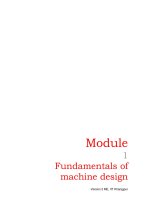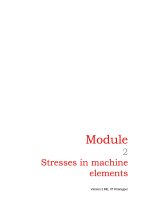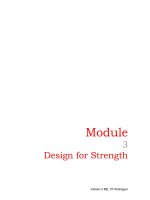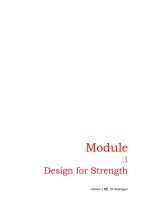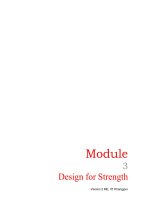Tài liệu Fundamentals of Machine Design P12 doc
Bạn đang xem bản rút gọn của tài liệu. Xem và tải ngay bản đầy đủ của tài liệu tại đây (436.77 KB, 16 trang )
Version 2 ME, IIT Kharagpur
Module
4
Fasteners
Version 2 ME, IIT Kharagpur
Lesson
2
Cotter and knuckle
joint
Version 2 ME, IIT Kharagpur
Instructional Objectives
At the end of this lesson, the students should have the knowledge of
• A typical cotter joint, its components and working principle.
• Detailed design procedure of a cotter joint.
• A typical knuckle joint, its components and working principle.
• Detailed design procedure of a knuckle joint.
4.2.1 Cotter joint
A cotter is a flat wedge-shaped piece of steel as shown in figure-4.2.1.1. This is
used to connect rigidly two rods which transmit motion in the axial direction,
without rotation. These joints may be subjected to tensile or compressive forces
along the axes of the rods.
Examples of cotter joint connections are: connection of piston rod to the
crosshead of a steam engine, valve rod and its stem etc.
4.2.1.1F- A typical cotter with a taper on one side only (Ref.[6]).
A typical cotter joint is as shown in figure-4.2.1.2. One of the rods has a socket
end into which the other rod is inserted and the cotter is driven into a slot, made
in both the socket and the rod. The cotter tapers in width (usually 1:24) on one
Version 2 ME, IIT Kharagpur
side only and when this is driven in, the rod is forced into the socket. However, if
the taper is provided on both the edges it must be less than the sum of the
friction angles for both the edges to make it self locking i.e
1212
α +α <φ +φ where
1
α ,
2
α are the angles of taper on the rod edge and socket edge of the cotter
respectively and φ
1
, φ
2
are the corresponding angles of friction. This also means
that if taper is given on one side only then
12
α <φ +φ for self locking. Clearances
between the cotter and slots in the rod end and socket allows the driven cotter to
draw together the two parts of the joint until the socket end comes in contact with
the cotter on the rod end.
b
d
d
2
l
1
d
1
l
d
3
d
4
t
1
4.2.1.2F- Cross-sectional views of a typical cotter joint (Ref.[6]).
4.2.1.3F- An isometric view of a typical cotter joint (Ref.[6]).
Version 2 ME, IIT Kharagpur
4.2.2 Design of a cotter joint
If the allowable stresses in tension, compression and shear for the socket, rod
and cotter be
t
σ
,
c
σ
and
τ
respectively, assuming that they are all made of the
same material, we may write the following failure criteria:
1. Tension failure of rod at diameter d
2
t
dP
4
π
σ=
4.2.2.1F- Tension failure of the rod (Ref.[6]).
2. Tension failure of rod across slot
2
11t
ddt P
4
π
⎛⎞
−σ=
⎜⎟
⎝⎠
4.2.2.2F- Tension failure of rod across slot (Ref.[6]).
t
Version 2 ME, IIT Kharagpur
3. Tensile failure of socket across slot
22
21 21 t
(d d ) (d d )t P
4
π
⎛⎞
−−− σ=
⎜⎟
⎝⎠
4.2.2.3F- Tensile failure of socket across slot (Ref.[6]).
4. Shear failure of cotter
2bt Pτ=
4.2.2.4F- Shear failure of cotter (Ref.[6]).
5. Shear failure of rod end
11
2d Pτ=l
4.2.2.5F- Shear failure of rod end (Ref.[6]).
d
2
t


